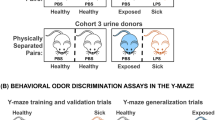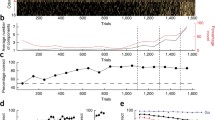Abstract
Mice can discriminate samples of urine obtained from two groups of inbred mice that are genetically identical except in their major histocompatibility complex (MHC) haplotype (congenic mice), whereas they cannot distinguish urine samples from two genetically identical groups of mice. Chemical fractions of urine samples obtained from MHC congenic mice were tested in a Y-maze olfactometer using a method modified to accommodate the bioassay to chemical fractions that might differ in sensory properties from the unfractionated urine. Fractions depleted in protein by several methods were consistently discriminable by mice in the Y maze, providing a direct demonstration that the airborne MHC genotype information can be conveyed by volatile compounds alone.
Similar content being viewed by others
References
Bowers, J.M., andAlexander, B.K. 1967. Mice: individual recognition by olfactory cues.Science 158:1208–1210.
Boyse, E.A., Beauchamp, G.K., andYamazaki, K. 1987. The genetics of body scent.Trends Genet. 3:97–102.
Boyse, E.A., Beauchamp, G.K., Bard, J., andYamazaki, K. 1991a. Behavior and the major histocompatibility complex of the mouse, pp. 831–846,in R. Ader, D.L. Feiten, and N. Cohen (eds.). Psychoneuroimmunology, 2nd ed. Academic Press, San Diego.
Boyse, E.A., Beauchamp, G.K., Yamazaki, K., andBard, J., 1991b. Genetic components of kin recognition in mammals, pp. 148–161,in P.G. Hepper (ed.). Kin Recognition. Cambridge University Press, Cambridge, U.K.
Garrett, T.P.J., Saper, M.A., Bjorkman, P.J., Strominger, J.L., andWiley, D.C. 1989. Specificity pockets for the side chains of peptide antigens in HLA-Aw68.Nature 342:692–696.
Howard, J.C. 1977. H-2 and mating preferences.Nature 266:406–408.
Hunt, D.F., Henderson, R.A., Shabanowitz, J., Sakaguchi, K., Michel, H., Sevilir, N., Cox, A.L., Appella, E., andEngelhard, V.H. 1992. Characterization of peptides bound to the class I MHC molecule HLA-A2.1 by mass spectrometry.Science 255:1261–1263.
Ivanyi, P. 1978. Some aspects of the H-2 system, the major histocompatibility system in the mouse.Proc. R. Soc. 202B:117–158.
Klein, J. 1986. Natural History of the Major Histocompatibility Complex. Wiley, New York.
Laemmli, U.K. 1970. Cleavage of structural proteins during the assembly of the head of bacteriophage T4.Nature 227:680–685.
Liebich, H.M., Zlatkis, A., Bertsch, W., Vandahm, R., andWhitten, W.K. 1977. Identification of dihydrothiazoles in urine of male mice.Biomed. Mass Spectr. 4:69.
Potts, W.K., Manning, C.J., andWakeland, E.K. 1991. Mating patterns in seminatural populations of mice influenced by MHC genotype.Nature 352:619–621.
Schumacher, M.J. 1980. Characterization of allergens from urine and pelts of laboratory mice.Mol. Immunol. 17:1087–1095.
Schwende, F.J., Jorgenson, J.W., andNovotny, M. 1984. A possible chemical basis for histocompatibility-related mating preference in mice.J. Chem. Ecol. 10:1603–1615.
Schwende, F.J., Wiesler, D., Jorgenson, J.W., Carmack, M., andNovotny, M. 1986. Urinary volatle constituents of the house mouse,Mus musculus, and their endocrine dependency.J. Chem. Ecol. 12:277–296.
Singer, A.G., andMacrides, F. 1992. Lipocalycins associated with mammalian pheromones,in R.L. Doty and D. Muller-Schwarze (eds.). Chemical Signals in Vertebrates 6. Plenum, New York. In press.
Singer, A.G., Clancy, A.N., Macrides, F., Agosta, W.C., andBronson, F.H. 1988. Chemical properties of a female mouse pheromone that stimulates gonadotropin secretion in males.Biol. Reprod. 38:193–199.
Singh, P.B., Brown, R.E., andRoser, B. 1987. MHC antigens in urine as olfactory recognition cues.Nature 327:161–164.
Singh, P.B., Brown, R.E., andRoser, B. 1988. Class I transplantation antigens in solution in body fluids and in the urine.J. Exp. Med. 168:195–211.
Voznessenskaya, V.V., Parfyonova, V.M., andZinkevich, E.P. 1992. Individual odortypes,in R.L. Doty and D. Muller-Schwarze (eds.). Chemical Signals in Vertebrates 6. Plenum, New York. In press.
Yamaguchi, M., Yamazaki, K., Beauchamp, G.K., Bard, J., Thomas, L., andBoyse, E.A. 1981. Distinctive urinary odors governed by the major histocompatibility locus of the mouse.Proc. Natl. Acad. Sci. U.S.A. 78:5817–5820.
Yamazaki, K., Boyse, E.A., Mike, V., Thaler, H.T., Mathieson, B.J., Abbott, J., Boyse, J., Zayas, Z.A., andThomas, L. 1976. Control of mating preferences in mice by genes in the major histocompatibility complex.J. Exp. Med. 144:1324–1335.
Yamazaki, K., Yamaguchi, M., Baranoski, L., Bard, J., Boyse, E.A., andThomas, L. 1979. Recognition among mice: evidence from the use of a Y-maze differentially scented by congenic mice of different major histocompatibility types.J. Exp. Med. 150:755–760.
Yamazaki, K., Beauchamp, G.K. Thomas, L., andBoyse, E.A. 1984. Chemosensory identity of H-2 heterozygotes.J. Mol. Cell. Immunol. 1:79–82.
Yamazaki, K., Beauchamp, G.K., Bard, J., andBoyse, E.A. 1990. Chemosensory identity and the Y chromosome.Behav. Genet. 20:157–165.
Yamazaki, K., Beauchamp, G.K., Bard, J., Boyse, E.A., andThomas, L. 1991. Chemosensory identity and immune function in mice, pp. 211–225,in C.J. Wysocki and M.R. Kare (eds.). Chemical Senses: Genetics of Perception and Communication. Marcel Dekker, New York.
Author information
Authors and Affiliations
Rights and permissions
About this article
Cite this article
Singer, A.G., Tsuchiya, H., Wellington, J.L. et al. Chemistry of odortypes in mice: Fractionation and bioassay. J Chem Ecol 19, 569–579 (1993). https://doi.org/10.1007/BF00994326
Received:
Accepted:
Issue Date:
DOI: https://doi.org/10.1007/BF00994326




